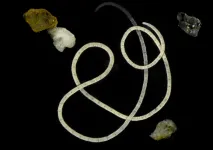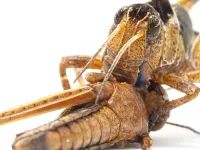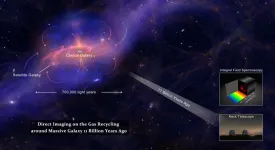(Press-News.org)
· No evidence of cytokine storm in critically ill patients with COVID-19
· Nearly half of patients with COVID-19 develop a secondary bacterial pneumonia
· Crucial to find and aggressively treat secondary bacterial pneumonia in ICU patients
CHICAGO --- Secondary bacterial infection of the lung (pneumonia) was extremely common in patients with COVID-19, affecting almost half the patients who required support from mechanical ventilation. By applying machine learning to medical record data, scientists at Northwestern University Feinberg School of Medicine found that secondary bacterial pneumonia that does not resolve was a key driver of death in patients with COVID-19. It may even exceed death rates from the viral infection itself.
The scientists also found evidence that COVID-19 does not cause a “cytokine storm,” so often believed to cause death.
The study was recently published in the Journal of Clinical Investigation.
"Our study highlights the importance of preventing, looking for and aggressively treating secondary bacterial pneumonia in critically ill patients with severe pneumonia, including those with COVID-19," said senior author Dr. Benjamin Singer, an associate professor of medicine at Northwestern University Feinberg School of Medicine and a Northwestern Medicine pulmonary and critical care physician.
The investigators found nearly half of patients with COVID-19 develop a secondary ventilator-associated bacterial pneumonia.
“Those who were cured of their secondary pneumonia were likely to live, while those whose pneumonia did not resolve were more likely to die,” Singer said. “Our data suggested that the mortality related to the virus itself is relatively low, but other things that happen during the ICU stay, like secondary bacterial pneumonia, offset that.”
The study findings also negate the cytokine storm theory, said Singer, also the Lawrence Hicks Professor of Pulmonary Medicine at Feinberg.
“The term ‘cytokine storm’ means an overwhelming inflammation that drives organ failure in your lungs, your kidneys, your brain and other organs,” Singer said. “If that were true, if cytokine storm were underlying the long length of stay we see in patients with COVID-19, we would expect to see frequent transitions to states that are characterized by multi-organ failure. That’s not what we saw.”
The study analyzed 585 patients in the intensive care unit (ICU) at Northwestern Memorial Hospital with severe pneumonia and respiratory failure, 190 of whom had COVID-19. The scientists developed a new machine learning approach called CarpeDiem, which groups similar ICU patient-days into clinical states based on electronic health record data. This novel approach, which is based on the concept of daily rounds by the ICU team, allowed them to ask how complications like bacterial pneumonia impacted the course of illness.
These patients or their surrogates consented to enroll in the Successful Clinical Response to Pneumonia Therapy (SCRIPT) study, an observational trial to identify new biomarkers and therapies for patients with severe pneumonia. As part of SCRIPT, an expert panel of ICU physicians used state-of-the-art analysis of lung samples collected as part of clinical care to diagnose and adjudicate the outcomes of secondary pneumonia events.
“The application of machine learning and artificial intelligence to clinical data can be used to develop better ways to treat diseases like COVID-19 and to assist ICU physicians managing these patients,” said study co-first author Dr. Catherine Gao, an instructor in pulmonary and critical care medicine at Feinberg and a Northwestern Medicine physician.
“The importance of bacterial superinfection of the lung as a contributor to death in patients with COVID-19 has been underappreciated because most centers have not looked for it or only look at outcomes in terms of presence or absence of bacterial superinfection, not whether treatment is successful or not,” said study co-author Dr. Richard Wunderink, who leads the Successful Clinical Response in Pneumonia Therapy Systems Biology Center at Northwestern.
The next step in the research will be to use molecular data from the study samples and integrate it with machine learning approaches to understand why some patients go on to be cured of pneumonia and some don’t. Investigators also want to expand the technique to larger datasets and use the model to make predictions that can be brought back to the bedside to improve the care of critically ill patients.
Other Northwestern authors on the paper include Nikolay S. Markov, Thomas Stoeger, Anna E. Pawlowski,Mengjia Kang, Prasanth Nannapaneni, Rogan A. Grant, Chiagozie Pickens, James M. Walter, Jacqueline M. Kruser, Luke V. Rasmussen, Daniel Schneider, Justin Starren, Helen K. Donnelly, Alvaro Donayre, Yuan Luo, Scott Budinger and Alexander Misharin.
The study was supported by the Simpson Querrey Lung Institute for Translational Sciences and grant U19AI135964 from the National Institute of Allergy and Infectious Diseases of the National Institutes of Health.
END
New York (May 4, 2023) — Today, the American Geriatrics Society (AGS) released the 2023 update to the AGS Beers Criteria® for Potentially Inappropriate Medication Use in Older Adults (DOI: 10.1111/jgs.18372). The AGS Beers Criteria® serves as a comprehensive list of medications that older people should potentially avoid or consider using with caution because they often present unnecessary risks for this population. Given that, according to the National Center for Health Statistics, United States (NCHSUS), more than 88% of older people use at least one prescription and more than 66% use ...
Continents are part of what makes Earth uniquely habitable for life among the planets of the solar system, yet surprisingly little is understood about what gave rise to these huge pieces of the planet’s crust and their special properties. New research from Elizabeth Cottrell, research geologist and curator of rocks at the Smithsonian’s National Museum of Natural History, and lead study author Megan Holycross, formerly a Peter Buck Fellow and National Science Foundation Fellow at the museum and now an assistant professor at Cornell University, deepens the understanding of Earth’s crust by testing ...
The North Pacific “Garbage Patch” is home to an abundance of floating sea creatures, as well as the plastic waste it has become famous for, according to a study by Rebecca Helm from Georgetown University, US, and colleagues, publishing April 27th in the open access journal PLOS Biology.
There are five main oceanic gyres — vortexes of water where multiple ocean currents meet — of which the North Pacific Subtropical Gyre (NPSG) is the largest. It is also known as the North Pacific “Garbage Patch”, because converging ocean currents have concentrated large amounts ...
Cholesterol and phytosterol are sterols, fatty compounds essential for many biological processes such as the functioning of cell membranes. Up to now, it has been assumed that phytosterols are characteristic for plants, and cholesterol for animals, and that only plants can make phytosterols, while animals typically make cholesterol. Dolma Michellod, Nicole Dubilier and Manuel Liebeke from the Max Planck Institute for Marine Microbiology in Bremen, Germany, were therefore surprised when they discovered that a small marine worm called Olavius ...
CORVALLIS, Ore. – New research led by an Oregon State University scientist begins to unravel the role dust plays in nourishing global ocean ecosystems while helping regulate atmospheric carbon dioxide levels.
Researchers have long known that phytoplankton – plantlike organisms that live in the upper part of the ocean and are the foundation of the marine food web – rely on dust from land-based sources for key nutrients. But the extent and magnitude of the impact of the dust – ...
Huge swarms of migratory locusts take on the proportions of natural disasters and threaten the food supply of millions of people, especially in Africa and Asia. As the eighth of the ten biblical plagues, the Book of Moses in the Old Testament already describes how swarms of locusts darkened the sky and ate up everything that grew in the fields and on the trees. Scientists suspect that cannibalism among locusts contributes to their swarming behavior, and swarms therefore constantly move ...
Swarming migratory locusts – which threaten food security across the globe – avoid being eaten by other locusts by producing a smelly pheromone called phenylacetonitrile (PAN), according to a new study. The discovery of an anticannibalistic signaling pathway in locusts could provide a target for locust management strategies since cannibalistic interactions among locusts have been implicated in creation of swarms, which are highly destructive. A wide range of species practice cannibalism, mostly to supplement nutrition. This has led to the evolution of ...
A randomized controlled experiment featuring more than 26,000 students across 22 4-year U.S. universities shows that the effects of a low-cost, brief online intervention focused on social belonging can promote success and equity for college students. This finding was particularly apparent among those from groups that have historically achieved at lower rates. The likelihood of earning a university degree in the U.S. is highly unequal across racial-ethnic and socioeconomic groups. In most cases, programs designed to help, by promoting college persistence, work differently for different people. Understanding these heterogenous effects ...
Streams of intergalactic gas, enriched with elements heavier than helium, encircle and spiral into a massive galaxy observed at redshift 2.3, researchers report. The findings provide evidence of enriched gas recycling during galaxy formation in the early Universe. Galaxies form through the accretion of gas from the circumgalactic medium (CGM) and intergalactic medium (IGM), which subsequently condenses into stars. Simulations and observations have shown that cold stream accretion – the accumulation of pristine intergalactic gas that contains almost no elements heavier ...
Reconstructing the bacterial genomes recovered from the calcified plaque of human and Neanderthal remains has offered new insights into previously undescribed Pleistocene bacterial metabolites, researchers report. The approach expands researchers ability to study microbial natural products, which has otherwise been mostly limited to studying living bacteria. Bioactive small molecules produced by microbes, often called natural products, have been an important source of diverse functional compounds for industry and medicine, including many antimicrobials. Characterizing the natural products encoded in biosynthetic gene clusters ...







